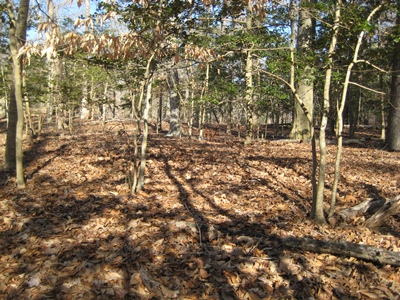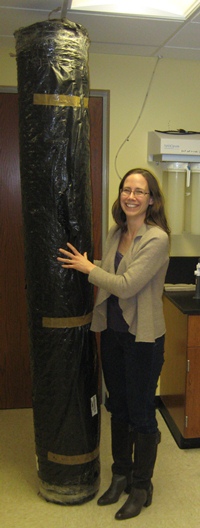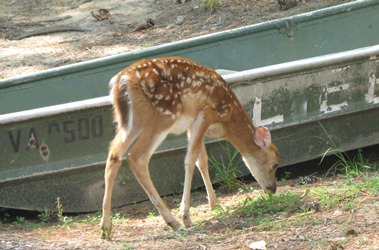Deer Browsing Draws Herd of Biologists
 The hot topic in and around Williamsburg these days is the intersection of deer and people—what to do about the conflict between humans and the burgeoning deer populations in our local surroundings? The general public can relate to issues that include: collisions between deer and motor vehicles; rampant browsing by deer of gardens and landscaping flowers and shrubs; the disturbing relationship between deer density and the incidence of tick-borne diseases in humans. In theory, some of these issues can be addressed by managing the deer populations somehow—keeping deer out of areas of concern, reducing deer fertility, and/or increasing hunting of deer locally (see a related article in the New York Times for biology professor Dan Cristol’s take on this). While the finances, logistics, and ethics of different management options are discussed by Williamsburg residents, the deer continue to thrive.
The hot topic in and around Williamsburg these days is the intersection of deer and people—what to do about the conflict between humans and the burgeoning deer populations in our local surroundings? The general public can relate to issues that include: collisions between deer and motor vehicles; rampant browsing by deer of gardens and landscaping flowers and shrubs; the disturbing relationship between deer density and the incidence of tick-borne diseases in humans. In theory, some of these issues can be addressed by managing the deer populations somehow—keeping deer out of areas of concern, reducing deer fertility, and/or increasing hunting of deer locally (see a related article in the New York Times for biology professor Dan Cristol’s take on this). While the finances, logistics, and ethics of different management options are discussed by Williamsburg residents, the deer continue to thrive.

Here on the W&M campus, deer sightings are common, with small herds of fearless deer emerging from the College Woods to browse on the vegetation in the open spaces around college buildings. The woods still are an important refuge for deer, however, providing shelter and—it turns out—diminishing supplies of food. Having browsed most of the succulent understory vegetation in the woods, the deer herds have resorted to eating plants they don’t usually like: lower-quality foods such as the leaves of holly and beech trees. The results of overgrazing in the College Woods are dramatic, as nearly every green thing lower than 6 feet off the ground has been eaten, and brown is the dominant color. Seedlings—the next generation of forest trees—aren’t making it. Perennial flowers and shrubs are emerging to flower, only to be consumed by hungry deer. The notably high diversity of plants gradually is being reduced by browsing. Species of birds that nest in the understory or on the ground increasingly are failing to reproduce. In short, the environmental impact of deer is analogous to the impact of the pulse of radiation from a neutron bomb: the buildings (trees) remain standing but all other forms of life are eliminated.
One way to examine the multifarious effects of deer is to compare sections of forest exposed to deer browsing with sections in which deer are excluded. The biology department is about to conduct this very experiment in the College Woods. A group of faculty led by assistant professor Dr. Harmony Dalgleish was funded this spring by the Morton Science Lab Fund to acquire materials to construct “deer exclosures” in the College Woods. At least six faculty members are involved: Drs. Case, Chambers, Cristol, Dalgleish, Leu, and Swaddle. The number, location, and size of the exclosures will be determined to exploit both teaching and research opportunities for biology students and faculty. The BIOL220 and 225 labs, for example, are slated to complete measurements in the exclosures and in adjacent areas still exposed to deer grazing. Measurement variables will include items like plant species diversity, plant biomass, and bird nesting. Tick surveys inside and outside exclosures will document whether vectors for human diseases are facilitated by deer.
According to Dr. Dalgleish, “I see the exclosures in the College Woods as a way for our students to learn about an important ecological question that has relevance for our campus and for Williamsburg. Because the exclosures will be used by multiple classes over the years, the labs students do in the Woods become an authentic model for experimental, long-term and collaborative ecological research.”
 Skip to main content
Skip to main content

